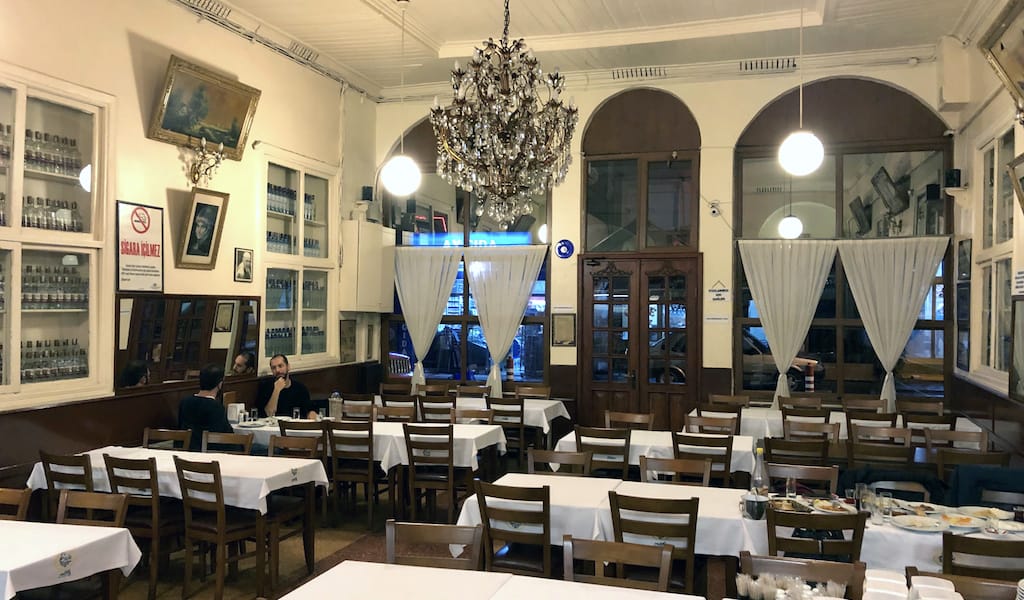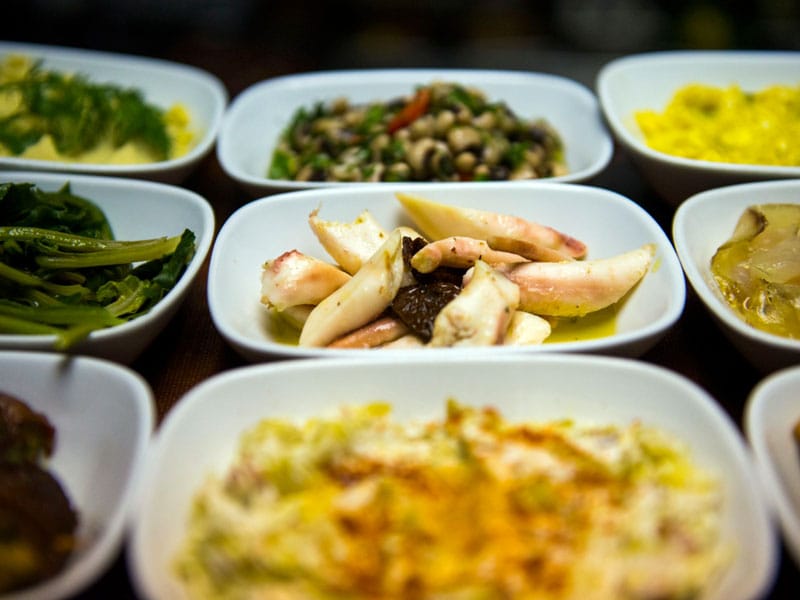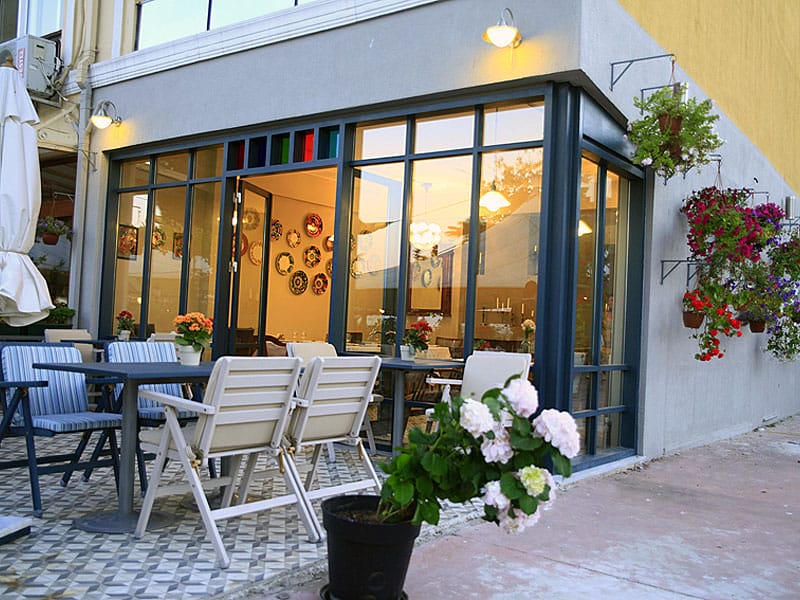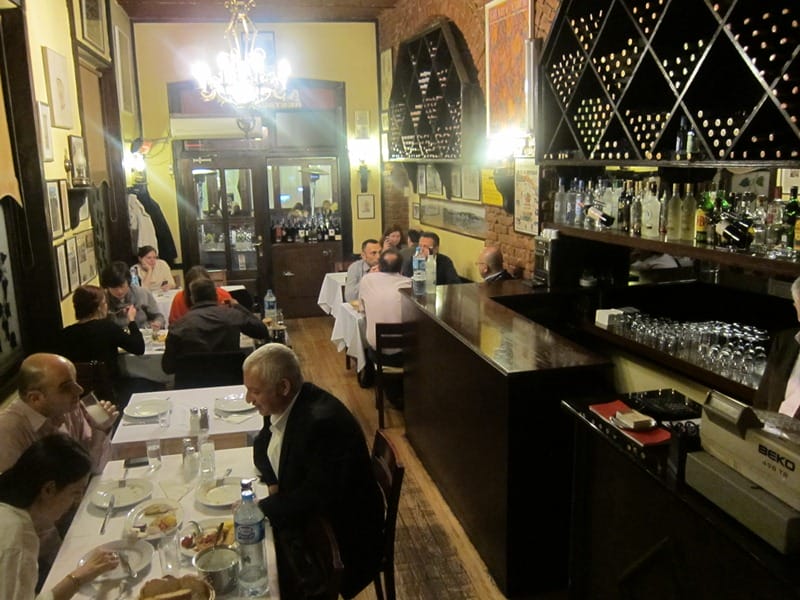This year we came across scores of new places and watched as bars and restaurants continue to sprout up throughout the city in defiance of Turkey’s severe economic downtown (as the saying goes, bars always do well in times of crisis).
But 2019 also involved discovering (and re-discovering) some classics that have weathered bad times both recent and distant, shining through it all with the gleaming beam of perfectionism and perseverance.
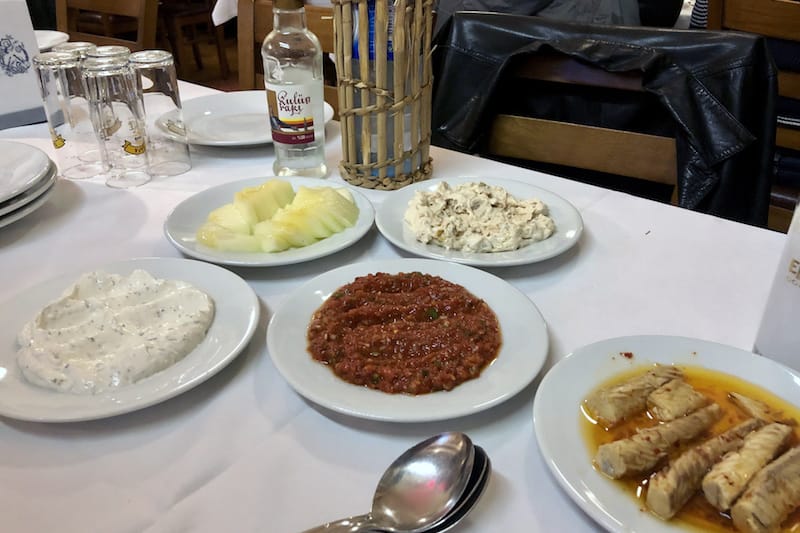
Safa Meyhanesi
Despite considering ourselves meyhane connoisseurs and having dined at nearly all of the city’s classic establishments, it was gnawing at us for months that we still hadn’t made it to Safa Meyhanesi, a legendary spot in the historic Yedikule neighborhood that’s housed in a 19th-century brick building. We had seen photos of the majestic dining room but they didn’t do justice to how we felt as we stepped inside, admiring the rows of empty bottles of Kulüp rakı encased on the walls, an elegant chandelier dangling gracefully from the ceiling, and a formidable framed photo of Atatürk above the entryway that leads from the dining room onto the back patio, illuminated with sparkling red lights.
At Safa it’s all about the meze. They serve grilled appetizers and fish, but we’d rather forgo those to assemble a hefty selection of their classic mezes, the best of which is the house specialty köpoğlu, a deceptively simple dish of grilled eggplant morsels doused in a dollop of garlicky yogurt. Safa’s version had a seductively tan hue, and while we couldn’t pinpoint why this was the best version of a meze we’ve had at so many other places, we were well aware of the fact nonetheless.
Safa was launched in 1948 by Süleyman Kızıltay, an Albanian-Istanbullu. Now the place is in the hands of his son Arif, who is in his late 70s but boasts a youthful, charming persona. He can usually be found in a corner of the restaurant behind his desk and has no shortage of stories regarding an Istanbul of the past that he was fortunate enough to have experienced.
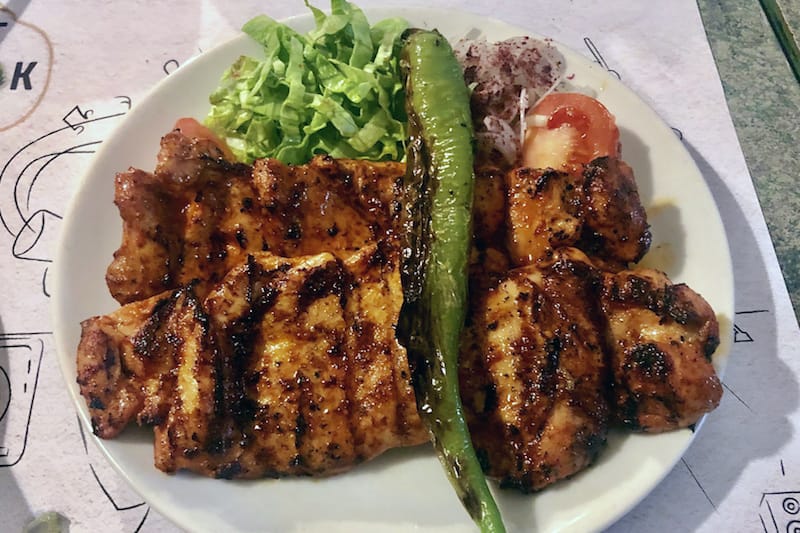
Bakar Ocakbaşı
We had been going to Bakar Ocakbaşı (also known as Şükrü Baba’nın Yeri) for years, but didn’t appreciate how great the place was until recently. It’s a fixture of the Hisarüstü neighborhood, a hilly, eclectic area home to equal numbers of people with working class migrant roots who built their houses on what was once open land and students of the prestigious Boğaziçi University – Turkey’s Harvard – whose two main campuses flank the quarter.
Since Bakar Ocakbaşı is a grill house, it keeps a minimal selection of meze, all of which are excellent. However, for some reason, it took us way too long to discover the signature dish: succulent boneless fillets of grilled chicken. We recall being in disbelief upon first bite, relishing in how flavorful and tender the chicken was, despite its lavish char.
If that weren’t enough, the father-son team of Cemal and Uğur who run the place are genuinely warm and friendly, as are their colleagues. The beer and rakı are served cold and at reasonable prices, and they keep them coming. Make sure to order the chicken on your visit so as to not miss out for years like we did.
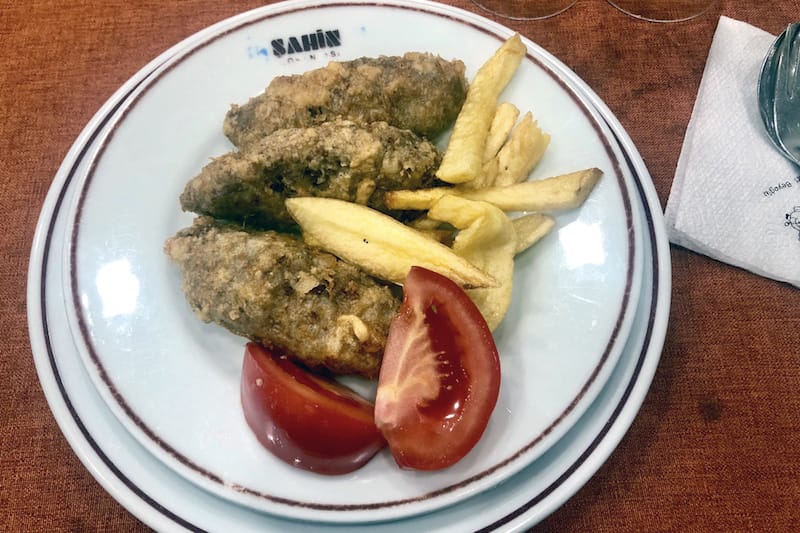
Şahin Lokantası
We were devastated to hear about the passing of Ismail Şahin, a beloved legend of Istanbul’s esnaf lokantası culture. Open for just over half a century, Şahin Lokantası has been a haven of affordable, delicious food enjoyed by a motley crew of workers, lawyers, students and even people living on the street, for whom Şahin would regularly provide meals free of charge. We popped in to try to speak with Şahin’s son Nazmi for a tribute profile on his father, though he wasn’t in. It was just two days after the funeral. We were almost alarmed at how everything continued as normal, as decades-long employees continued to churn out dish after dish despite clearly reeling from the loss of their longtime boss, who was so much more than just that.
We were hungry and ordered a portion of the kadınbudu köfte, which we had smelled the moment we walked in the door. The dish is tantamount to slightly crispy, lightly fried pouches of meatloaf, and we’ve never had a version as tasty and fresh as the one Şahin Lokantası serves. The next day, we managed to speak with Nazmi, who was back at work just three days after burying his father. He has vowed to continue to run Şahin Lokantası the way it always has been, ensuring that the spirit of his father will never die.
– Paul Benjamin Osterlund
Parsley and Lemon
One Wednesday in early spring, when the cold has just barely released its grip on the city and lengthening days whispered the promise of new seasonal delights to eat, I took a trip down the hill to the weekly market that lines Cin Deresi Caddesi in the depths of Feriköy. I was shopping for a dinner with friends later that day and, unsure of what to buy, wandered past stalls packed with potatoes, onions and scarlet-red fresh strawberries, eventually coming to a stop in front of a stand selling greens at the mouth of the market. I feasted my eyes on the bundles of spinach, herbs and lettuce artfully stacked chest high. One of the sellers, seeing his chance, deftly selected the freshest bundle of parsley, shook the water clinging to its leaves, releasing its characteristic fragrance, and held it towards me as one would a bouquet of flowers. I leaned in and inhaled, instinctively, letting the fresh green aroma fill my nose, before handing over a mere two liras for this bundle of goodness.
Later, around a table of friends, the host took this offering of spring I had brought, placed it on a plate and squeezed a late winter lemon from their family’s orchards in Antalya over it, finishing it with some grains of salt. We proceeded to graze shamelessly, munching like rabbits and marveling at the pinnacle of freshness we had found in this combination of three simple ingredients.
Uzbek Somsa at Samarkand
The side streets off Söğütlüçeşme Caddesi in Kadıköy hide a number of Uzbek and Turkmen restaurants, each offering more or less the same dishes for similar prices. I seem to stumble across a new one every week, and the competition between these joints has spawned some particularly eye-catching marketing schemes. One such restaurant recently installed two windsocks, the kind you might see beckoning you to a gas station or a çiğ köfte stand but in traditional Turkmen garb, outside their door. Another features a family of faceless mannequins, similarly dressed and seated before a feast, in their front window.
Publicity stunts aside, there is some tasty grub to be found at these places, and my favorite morsel is the somsa, a crispy tandir oven-baked dumpling filled with lamb meat. Perhaps the best one of the year was had on an autumn afternoon, at a spot called Samarkand. This place offers the full Uzbek experience, complete with black lights and photographs of the country’s most famous historical sites. I ordered a bowl of lagman, pilav and a number of somsas. An older man, presumably the owner, came over to inform me that the somsas, unfortunately, had gone into the oven shortly before I arrived, and would require at least a 20-minute wait. I was in no hurry, and regardless I had to sample some in the name of science.
I was not disappointed when the somsas arrived, asymmetrical packets of dough too hot to eat immediately, not as oily and flaky as some others I had tried before but pleasantly toothsome, filled with perfectly cooked meat swimming in a flavorful broth of onions and spices. When I finally dared to bite into one, the fragrant steam filled my mouth. I chewed thoughtfully and found myself transported to a place thousands of miles away that tasted, comfortingly and inexplicably, like home.
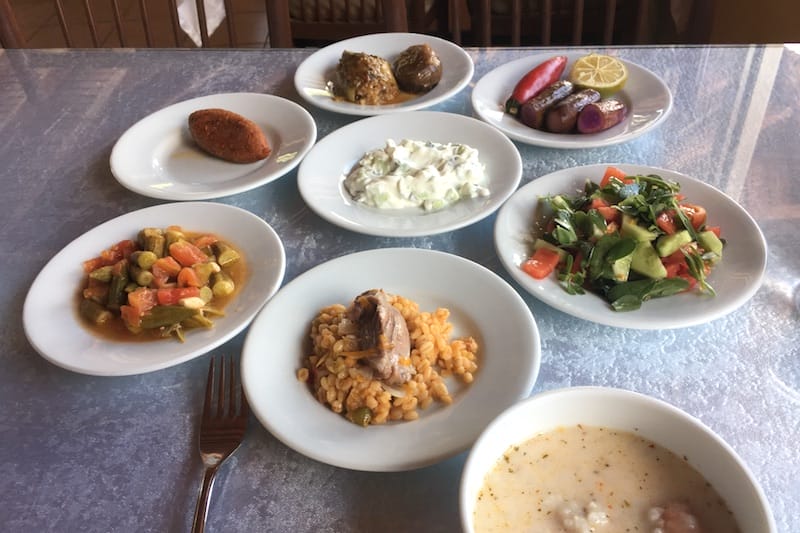
Dolma at Ali Mürdüm’ün Yeri
Ask the average Turkish person and he or she will insist that the best food in the country is to be found at their mother’s house. One of the great frustrations of being a foreigner in Turkey, and further still, a foreigner in Turkey writing about food, is that true homemade Turkish food can be somewhat difficult to come by. Fortunately for me, many Turks will allow that food from the culinary meccas of Gaziantep and Hatay, with their distinct and tantalizingly flavorful cuisines, come in close second.
On a recent trip to Hatay with friends, following a night of binging on künefe and wandering the old town of Antakya, both our stomachs and our legs demanded a break. Regardless, we were feeling a bit peckish, so we crossed Kurtuluş Caddesi and climbed the hill in search of Ali Mürdüm’ün Yeri, a restaurant that a friend of mine had recommended above all others. When I asked for further information all he would reveal was that Ali usta was a “special person.”
Once we had passed the edges of the historic Old Town, we lost our bearings a bit and stopped at a small snack shop to ask for directions. The name clearly sparked some recognition, as the man behind the counter smiled and pointed us to a two-story building perched impossibly on a sloping road overlooking a citrus grove. We wandered over and poked our heads through the open door downstairs. An older man and woman were sitting in what appeared to be a kitchen, but there was no clear sign of either food or the characteristic bustle of working kitchens. “Is this a restaurant?” I asked sheepishly. “No,” was the flat reply. But as we turned to beat a disappointed retreat, the old man called us back, “Don’t you want to eat?” We nodded and he led us to an upstairs dining room with a view over the town.
We quickly regretted coming on anything less than an empty stomach. After expressly ordering just three dishes from the rather meek teenage server, eight arrived in quick succession, starting with a soup of yogurt and dumplings made from bulgur, and ending with a distinctly Hatay spin on a crème brûlée. Ali usta, the older man we had met earlier, brought them over himself, placing each on our table with the affirmation, “You definitely must try this – it’s very good.” Two other tables, a father and son and a couple from out of town, were taking a late lunch as well, and in between showering us with attention that seemed both motherly and disapproving, Ali usta hovered around the young boy, encouraging him to eat more of the cigarette-thin stuffed grape leaves, which he assured him were the best things on the table.
However, I found myself more partial to his dolma, or stuffed vegetables. Turkish cuisine is replete with food items stuffed with seasoned rice, utilizing packaging that ranges from tiny hamsi to intestines. But Ali usta’s stuffed zucchini and eggplant, swimming in a red, olive oil-rich broth, hit notes of sour and savory unlike any other stuffed food I had tried before. The vegetables themselves were petite, melt in your mouth tender morsels, and the rice was laced with fresh herbs, pepper and tomato paste, and sumac, giving the dolma their characteristic tang.
By the time he brought over our check – 40 TL per person for a veritable feast – and a steaming cup of tea, we were fit to burst. But as we left this truly special spot I could not help but eye the dolma, wondering if I could manage another bite or two. Ultimately, as I rolled the taste and the experience around in my mind afterwards, I realized that Ali usta’s place, and his food, embodied much of what I love about Turkish cuisine. It was homey, handmade food for the mouth and not the eyes, served with a fair helping of tough love and chaotic hospitality. Even now, as winter falls over Istanbul, my stomach dreams of Ali usta’s dolma, like an old relative we long to visit again.
– Geoffrey Ballinger
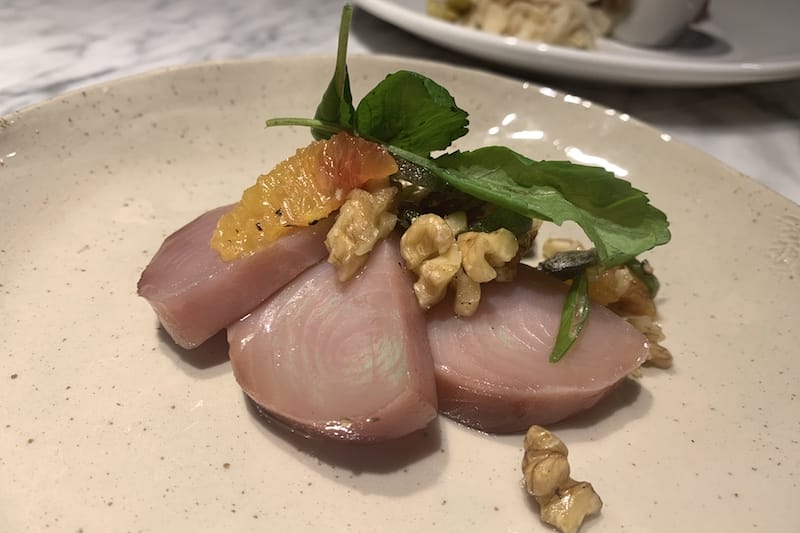
Lakerda at Gram
Didem Şenol, a young and successful chef who made a name for herself on the Istanbul culinary scene with Lokanta Maya, her now-shuttered fine-dining restaurant, is walking around the stands of Kadıköy’s Salı Pazarı with the agility of a ballet dancer. With a discerning eye, she picks all different kinds of fresh spring produce. Just a few hours later, we are sitting at Gram, her bistro inside Kanyon mall (which is now closed, although there is still Gram Corner in Kanyon and Gram in Maslak, as well as her latest venture, Zuko, a Turkish fast-food joint in Maslak). In the cozy atmosphere of the restaurant we are showered with love by the staff, while Şenol gets cooking.
The first dishes hit the table: earthy tulum cheese combined with perfectly roasted pumpkin, delicious vegetarian patties, and beetroot couscous. Our eyes feast on the vivid colors. But soon our attention turns to Şenol – she’s absorbed in her work, using the produce we bought together at the market as well as preserved delicacies that she sources from her trusted fishmonger and turşucu (pickle guy) in the Beyoğlu fish market, to create a brand new dish, just for us.
The finished plate is one of perfect harmony: fresh raw walnuts, baby arugula, some citrus slices and the inimitable lakerda, pickled bonito, which melts in our mouth and nicely contrasts the crunchiness of the nuts. We dive in, eager to taste the various complexities of what, on its face, looks to be a very simple dish. Likewise, the restaurant staff jumps on the portion Şenol has prepared for them to taste. In this familiar, warm atmosphere, she watches us devour the dish with the passion of a chef who loves to see her customers happy, and also with the amusement of an old friend who knows how much we enjoy eating. And we think that look is, in fact, the secret to all this deliciousness.
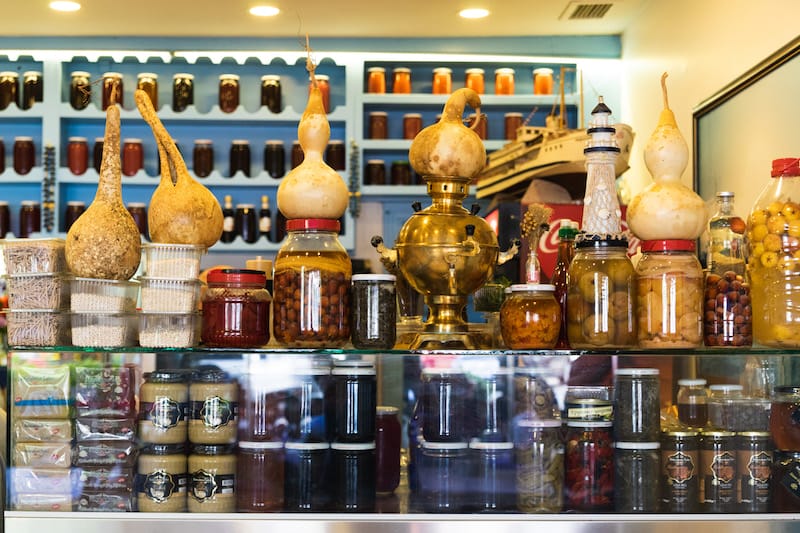
Pickled Delights at Içkisiz Balıkçı Anne
We have been sitting at this little eatery for over an hour, but we still can’t stop savoring the many different foods that Nuri and his family have offered (and continue to offer) us. With the crochet decorations, old pictures, big jars and vases of dried flowers, this place looks a lot like grandma’s living room. And Nuri’s mom – the eponymous balıkçı anne behind this quiet spot in the remote village of Rumeli Kavağı on the Bosphorus – is the woman who gives the magic touch to all the dishes coming out of the kitchen.
While wondering what the old lady did to make the salça we are eating so rich and flavorful, Nuri comes over with a couple of jars he took from the shelves before us. They contain preserved goods that remind us of the old days (which are, in fact, not that long ago) when preserving food was a necessity. But the jars in front of us are not full of the classic pickles or candied fruit – no, what Nuri offers us are two very special products that the family, which hails from Thrace, picked in the mountains close to their hometown. The pickled wild parsley is a salty, pungent herb that perfectly balances the rich foods we have been eating. But perhaps more interesting, flavor wise, is the pickled baby pear Nuri plucks from an oddly-shaped vase – the acidity of the fermenting juices and the natural sweetness of the pear are a perfect match.
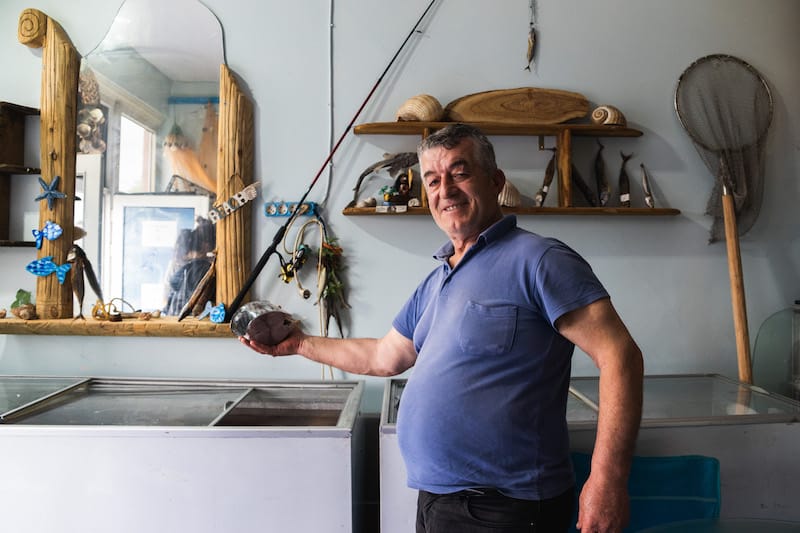
Cured Fish at Rumeli Kavağı Lakerda Balık Şarküteri
Pulling fish out of a bucket where it was marinating, Ahmet struggles to remember the Italian words he learned while working as a fisherman in the Mediterranean. He looks at his carefully cured fish – lakerda – as if it was made of gold, and handles it as if he were touching the most precious silk. We can sense how much effort he has put into fishing (and curing fish) over his lifetime, and even more, we can taste it. The salty anchovies that can be seen drying all around his fish lab in the village of Rumeli Kavağı and the buttery lakerda he meticulously cleans before our eyes are the result of years of experience and a fine palate.
So small that it seemingly couldn’t fit more than three people standing, the tiny shop turns into a rustic dining room as Ahmet and his friend Halit are frying freshly caught hamsi coated in corn flour. A salad, some rakı, fragrant bread and the fried fish: the sofra – a banquet-like table – is ready, and we are ready to listen to Ahmet as he tells us of his adventures in the Northern Seas and the struggle of returning to his hometown, where the local fishermen are disappearing and their children are moving to the city. His stories do not always have a happy ending, but they are captivating and bittersweet. His wisdom and life experiences remind us of his lakerda, whose brine is perfectly balanced – not too salty, just enough to bring out the taste of the sea, and slightly sweet to mitigate the wild flavor of the bonito.
– Lorenza Mussini
 July 22, 2013 Cibalikapı Balıkçısı
July 22, 2013 Cibalikapı Balıkçısı
On a night out in Istanbul, we often find ourselves forced to make sacrifices in one or […] Posted in Istanbul April 8, 2013 Heyamola Ada Lokantası
April 8, 2013 Heyamola Ada Lokantası
Editor’s note: This post was written by “Meliz,” an intrepid explorer of Istanbul’s […] Posted in Istanbul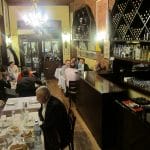 November 26, 2012 Asmalı Cavit
November 26, 2012 Asmalı Cavit
We can’t prove it, but we suspect a network of tunnels lies underground in Beyoğlu that […] Posted in Istanbul
Published on December 27, 2019
Related stories
July 22, 2013
IstanbulOn a night out in Istanbul, we often find ourselves forced to make sacrifices in one or more categories of the overall dining experience. Great food at reasonable prices will surely be laid out in a room decorated in Anatolian kitsch. Bosphorus views and contemporary furnishings are a license to gouge and serve up flaccid…
April 8, 2013
IstanbulEditor’s note: This post was written by “Meliz,” an intrepid explorer of Istanbul’s culinary backstreets and frequent Istanbul guest contributor who would like to keep her anonymity. While the Princes’ Islands make for a great escape from the city, it used to be hard to think of them as a culinary destination. That is, until…
November 26, 2012
IstanbulWe can’t prove it, but we suspect a network of tunnels lies underground in Beyoğlu that connects most of the meyhanes of Asmalımescit and Nevizade Sokak to the same mediocre kitchen, resulting in unexceptional mezes at scores of venues in this dining district. Following a number of tips, our search for a standout meyhane led…







































